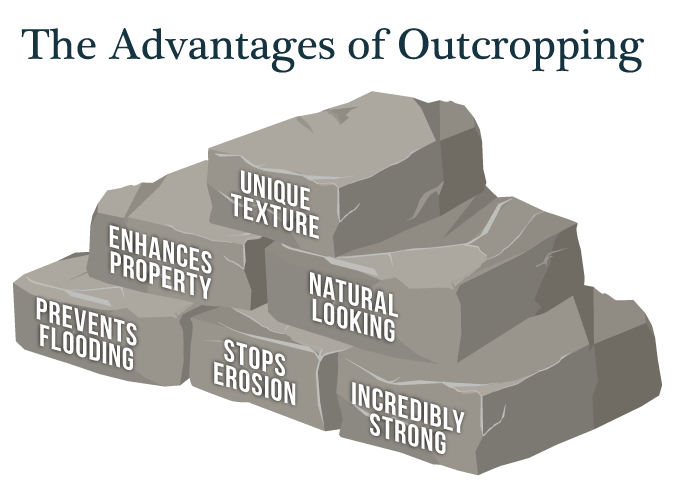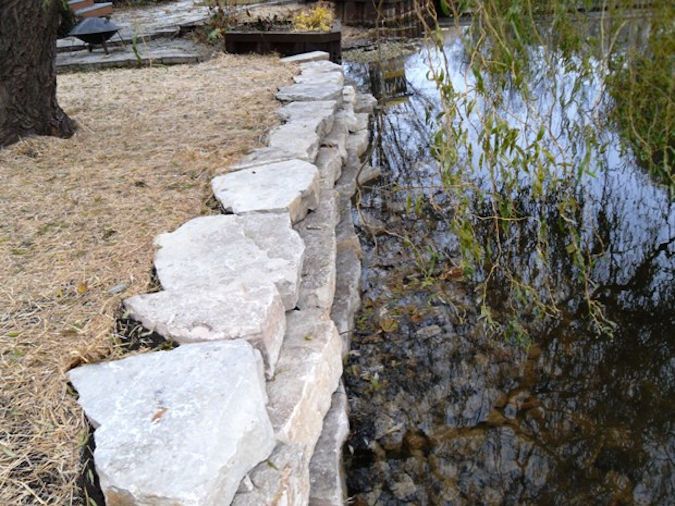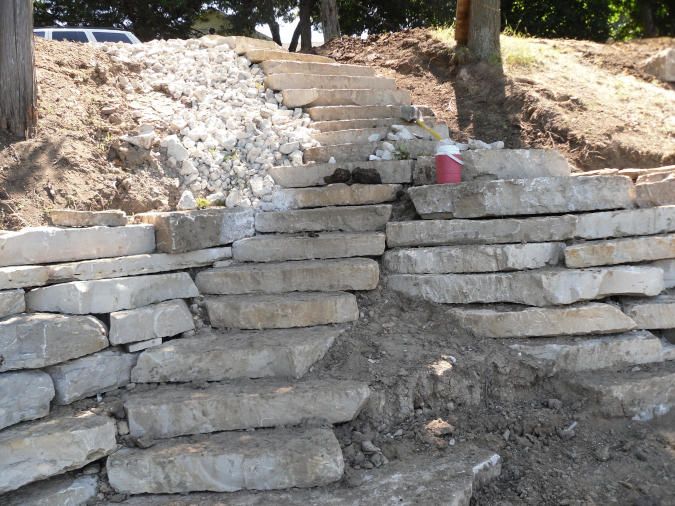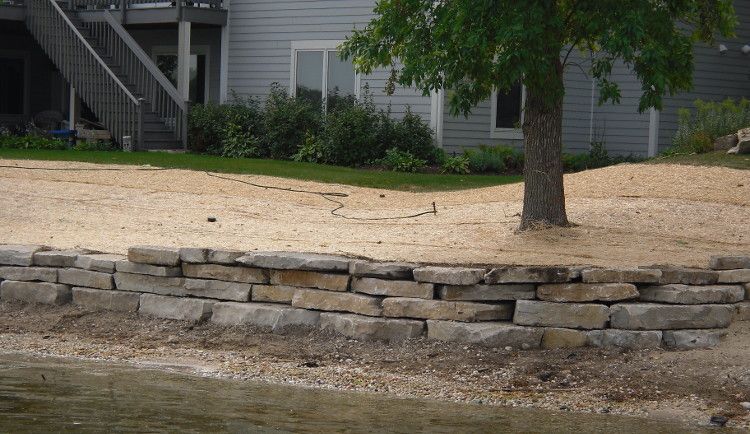See How Installing Outcropping Seawalls Can Help Keep Your Property Safe!
Are you looking for a way to protect your home from flooding and your shoreline from eroding? And do you want a design that is unique to your home as well? If so, outcropping seawalls are the answer you’re looking for!
Like steel and rip rap seawalls, outcropping defends against flooding, erosion, and other harmful elements. It also faces off against harsh waves and frequent clashes of water from heavy wake areas.
Outcropping can give your home terrific protection through the sturdy, reliable rocks we use. Keep reading our outcropping guide to learn more about how outcropping works.
What Are Outcropping Seawalls?
An outcropping retaining wall acts as a barrier between your home and the water. Positioned on the shoreline, these heavy slabs of rock are placed strategically to reduce the risk of harmful elements.
You have probably seen outcropping before, whether it is man-made or natural. Outcropping occurs when stones or rocks jut out of the ground.
Outcropping can be made from several different types of rocks. At Seawalls Unlimited, we use limestone because it is time-tested and durable.
We set the slabs of rocks in rows across the shoreline. We then layer more stones on top. Each stone is cut in a slightly different, irregular shape, giving the shoreline a more rugged, natural look.
Other seawalls have different feels and aesthetics to them, but all help with flood control and erosion. Outcropping also allows you the option of using unique patterns and colors and preserving a natural feel for your property.

What Is the Process for Installing Outcropping?
Installing outcropping is not a do-it-yourself project. After all, heavy equipment and machinery are needed for each stage of the installation process. At Seawalls Unlimited, we have a well-proven method for providing safe, fast installation.
Here’s how to build a stone retaining wall in a nutshell:
Prepare the Ground
The first thing we do to the shoreline is prepare the ground. Because the slabs of rocks are going to be placed there, the ground needs to meet certain criteria.
One essential requirement is that the ground must be level. When it’s on a shoreline, you want to make sure the surface is as flat as possible. This is done using backhoes to excavate the ground.
Once excavated, there should be no excess surface water in or around the ground. Excess water can seep into the stones and weaken them.
Finally, we secure a filter fabric to the ground. This filter fabric is commonly attached with a 6” steel staple. Having the filter fabric helps sift out any unnecessary water that could get in after installation.
Use Limestone
As said above, we use limestone to make our outcropping. Our limestone comes from a quarry in the Midwest and provides sturdy protection against harmful elements.
Limestone is also used in the construction of many things. Some of the oldest man-made structures were constructed using limestone. So, you know it can stand the test of time!
Limestone also contributes to the unique look of outcropping. In shades of orange, yellow, brown, and grey, limestone offers more colorful options than rip rap or steel.
Set Down Limestone
After the ground is prepared and the limestone is ready, it is time to put down the stones.
We place each piece over the filter fabric. The irregular shapes and sizes fit together like a jigsaw puzzle. Each piece adds to its defining shape and pattern.
We make sure the limestone is level on the ground and that there aren’t any gaping holes in between them. After all, large gaps between the stones can lead to the stones weakening.
Finally, we fill in gravel and dirt around the limestone so that everything is sealed. This step also helps the limestone blend into the surroundings. For this reason, it can be difficult to tell between man-made and natural outcropping walls.
Why Choose an Outcropping Retaining Wall?
People go with outcropping walls for many different reasons. It could fit with the shape of their shoreline. Or they could prefer the natural, rugged look outcropping offers. It could also be because of how much activity comes from the water. However, those are only side perks of outcropping.
The main reason for using outcropping is the practicality and protection it offers. Here is how outcropping defends your shoreline, your home, and the environment:
Flood Control
During the preparation stages, we remove surface water from the building site. However, there is also something called groundwater. Groundwater resides in soil, sand, and rocks. It supplies drinking water for more than half the U.S. population and helps irrigate crops.
Consistent heavy rainstorms or waves crashing on the shoreline increase the amount of groundwater in a certain area. This leads to floods. If your shoreline floods, it can get into your property and damage your belongings.
When the water levels are higher than ground level, there is nothing to prevent water from flooding into your home. Outcropping prevents that flooding by blocking off access to the ground. It deflects the crashing waves and defends against rain.
And, as stated above, our outcropping stones come from limestone, giving you the sturdy, durable defense your home needs.
Erosion Control
Like other seawalls, outcropping defends your shoreline against erosion. Erosion is when the repeated motion of water wears away at something. This could be a shoreline or area of land that water hits consistently. Installing outcropping helps reduce the risk of erosion on your land.
Living on an area with a constant wake from boats or other watercraft increases the chances of erosion. Likewise, a high number of waves from the water can also lead to erosion. The water strips away the protective layers the environment provides. It then becomes easier for other harmful elements to damage your property.
Furthermore, erosion can be caused by high winds, stormy weather, and ice and shifting temperatures. The McHenry County and Chicago regions have major shifts in weather patterns that can lead to erosion.

What Maintenance Do Outcropping Seawalls Need?
After we install your outcropping retaining wall, how do you keep it from weakening? This requires some slight maintenance.
Here are some guidelines to keep in mind when taking care of your outcropping:
Avoid Excessive Cleaning
This seems a bit confusing. Shouldn’t you clean your seawall? If one of the reasons you installed a seawall was for the appearance, you want it looking nice and tidy. However, excessive cleaning can lead to wearing down the limestone appearance.
You should never use abrasive cleaners on your outcropping. Limestone is vulnerable to acids, such as citrus, vinegar, or ammonia. Those chemicals will eat away at the surface. It will weaken the limestone and negatively affect its appearance. It also roughens the surface, making them prone to hold more dirt and algae. You should also avoid power washing the outcropping.
Instead, when you clean your outcropping, use a hose and gently scrub the offending area. You can use soap as well. Just make sure it doesn’t contain chemicals that will eat away at the surface.
Check Ground Conditions
While the outcropping walls shows off a natural look, you don’t want it to be too natural. Check your ground for invasive plant species. Weeds especially will snake into the outcropping and cause cracks in it. You should use weed killer around your seawall to ensure no invasive plants harm it.
The inspection of ground conditions includes checking for weep holes as well. Weep holes are holes in the ground that let water in from behind the seawall. If any of the weep holes are blocked by debris or garbage, pressure builds up and leads to problems. So, clear any weep holes of blockage to ensure that water is filtering at the right pace.
What Is the Cost of Outcropping Seawalls?
The individual cost of installation depends on each project. The outcropping stone prices could vary project-to-project. Each installation of outcropping walls is individualized based on the location and what the customer is looking for.
However, the cost of not installing an outcropping seawall could be much higher. Shoreline erosion and home flooding damages could have devastating price tags. This is especially an area of concern for those who live in an area prone to flooding. After all, flood insurances might not cover things like personal belongings in your basement. For this reason, installing outcropping walls could save you money in the long run.

What Are the Other Uses of Outcropping Walls?
Outcropping isn’t just used for shoreline protection. In fact, it can be used to accentuate your home and protect areas like your garden. The irregular shapes and varying colors help give your home a distinguished look.
Outcropping landscape design includes areas around gardens or outside plants that you want to protect. The landscaping stones also work as barriers up against your house for even more defense from flooding and erosion. Using large retaining wall blocks helps fend off watershed and elements that cause harm to your home.
People have used outcropping for appearances as well. If the grade of your land is too steep, you might not want to excavate it. Instead, placing outcropping stones along the grade adds accents to sloped areas. Limestone can also be used as steps along the property or leading up to your home.
Installing Outcropping Gives You Secure Protection
Are you ready to take the next step to give your home and shoreline the best possible protection? Do you live on a lake or body of water that causes erosion and flooding? If so, outcropping walls might be your best option.
Installing an outcropping wall looks like a large project. So, why not just let the professionals take over? We have the experience and know-how. Over the years, we have become the number one retaining wall repair and installation company in the entire Midwest. Our experience ensures that you have the best protection possible!

